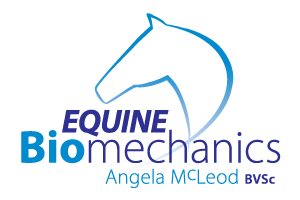Saturday 25 October 2014
The veterinarians view of auxiliary reins/ gadgets
Wednesday 24 July 2013
Bad Instructions
The contact (or connection) COMES FROM THE HIND LEG!!!!!
The trainers should instead shout MORE INSIDE LEG to get the horse to bend correct and stretch the outside rein.
Pulling on the reins will disrupt the horses balance and make the job even harder for the as yet weak hindlimbs.
Sunday 16 June 2013
Equine Performance Analysis
Correct training and systematic strengthening of the horses back is essential for optimum performance and longterm soundness of the equine athlete.
Tuesday 11 June 2013
Good explanation of contact by Thomas Ritter
The specific amount is determined, among other things, by how much thrust the hind legs develop, and how much they carry at the same time. If the hindquarters push more than they carry, the horse will lean heavily onto the hand. If the hindquarters carry more than they push, the horse sucks back and the rein contact becomes too light.
Closely related to the rein contact is the balance. A balanced horse, i.e. a horse that moves in self carriage, can also be light in hand. By contrast, a horse that is on the forehand will either lean heavily onto the bit, or it will curl up or invert.
A horse that is crooked will take too much contact on one rein and too little on the other. A horse with a high croup and straight hind legs will also tend to take a heavier rein contact.
A horse with a low set, short, thick neck and fleshy poll will also tend to take a heavier rein contact.
Horses with a long, slender, high set neck, on the other hand, will always tend tob e too light in hand and show a tendency to curl up.
The rider’s seat plays a role as well. If the rider tips forward, without sufficient engagement of his core muscles, he pushes the horse’s shoulders into the ground, and the horse onto his hand. However, if he sits up straight and engages his core muscles sufficiently, this will in itself often be enough to make the horse light(er) in hand.
If the rider drives too much by pushing forward with his pelvis, this will also push the horse heavily onto the bit.
If the tempo is too fast or too slow, the horse cannot find ist balance, which will also have repercussions for the rein contact.
A horse that is nervous for some reason will often take too much rein contact as well.
Many riders are concerned with the rein contact being too heavy. But there is also such a thing as not enough rein contact. When the rider can no longer feel the horse’s hind legs in his hands, because the horse is no longer seeking the communication through the rein, then the rein contact is too light. The conversation, the energy circuit, and the circle of aids have ceased.
A rein contact that is a little too heavy is still better than a non-existent rein contact, because in the first case, you can still have a conversation with the horse, whereas in the second case the horse has discontinued the talks."
(Thomas Ritter)

Monday 13 May 2013
Losgelassenheit - Suppleness and relaxation
Raising the back
Some basic anatomy
The horses back is a bridge between the forehand and hindquarters. It is composed of many individual bones called vertebrae. The neck has 7 cervical vertebrae, these are connected to 18 thoracic vertebrae, followed by 6 lumbar, 5 fused sacral and around 20 tail vertebrae. The sacrum is an integral part of the pelvic girdle and it is this joint (the sacroiliac joint) that the vertebral bridge receives the entire thrust from the hindquarters which gets transferred over the back as forward movement.
All the vertebrae have prominent spinous processes which project upwards. The spines of the front half of the back point backwards and those of the back half point forwards. The tops of the spinous processes are connected by a tendinous ligament (the supraspinous ligament which becomes the nuchal ligament as it extends from the withers to the head. This is the upper brace of the vertebral bridge. The lower brace, running from the breastbone to the pelvic girdle is made up of a mass of tendons which fuse into the central linea alba.
The horses back is often likened to a suspension bridge with levers at both ends. The front lever is made up of the neck (the nuchal ligament and upper neck muscles) and these do the job of pulling the backwards facing spinous processes forward and thus raising the back.
At the other end, muscles of the hindlimbs and the abdominal muscles working via the sacro-iliac joint, raise the back from behind by pulling on the spinous processes of the vertebrae further back which are oriented facing forwards.

